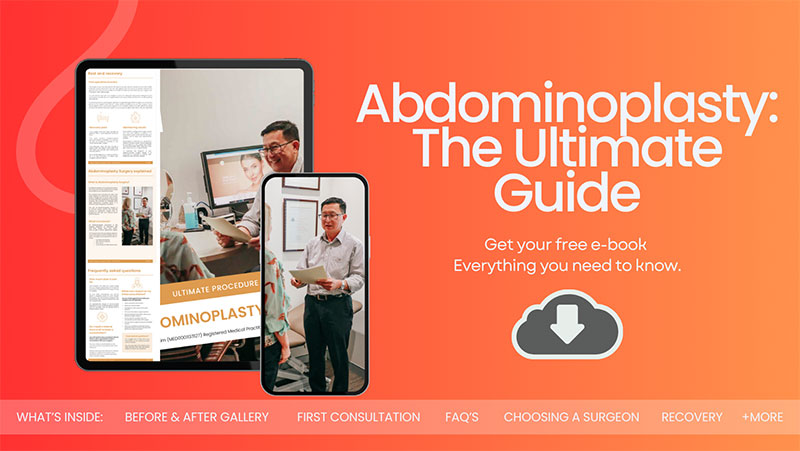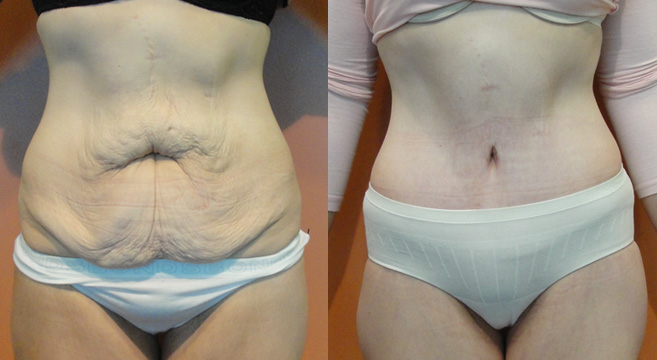Tips to Reduce Your Abdominoplasty Scars
Abdominoplasty, also known as a tummy tuck, is a surgical procedure that removes excess fat and skin from the abdomen, tightens the muscles, and repositions the navel. While abdominoplasty can significantly alter the appearance of the abdomen, it does leave behind scars. In this blog, we will discuss 5 methods to reduce your abdominoplasty scars.
Sydney Plastic Surgeon Dr Jake Lim is committed to helping his patients navigate the recovery after abdominoplasty to achieve optimal results.
Dr Lim’s 2024 Abdominoplasty Guide

The location and appearance of abdominoplasty scars vary depending on the individual’s anatomy and the plastic surgeon’s technique. However, most scars are located in the lower abdomen, running from hip to hip. While there is no way to completely eliminate abdominoplasty scars, there are a number of methods that can help to reduce their appearance. Here are five methods:
1. Good wound care
The first few weeks after surgery are critical for scar healing. It is important to keep the incisions clean and dry, and to apply antibiotic ointment as directed by Dr Jake Lim. You may also be given compression garments to wear, which can help to reduce swelling and improve scar healing.
- Cleaning the incisions: You should clean your incisions around the umbilicus with soap and water once a day. Be sure to dry the incisions thoroughly after cleaning them
- Applying antibiotic ointment: Dr Lim may prescribe an antibiotic ointment to help prevent infection. Apply the ointment to the incisions as directed by your plastic surgeon
- Wearing compression garments: Compression garments help to reduce swelling and improve blood circulation. This can help to promote healing and reduce the risk of scarring. You will be asked to wear compression garments for several weeks after surgery
2. Massage
Once your incisions are healed, you can start massaging the scars. Please check with Dr Lim before doing this. This helps to break up scar tissue and improve the appearance of the scar. You can use a variety of massage oils or creams, or simply use your fingertips.
- How to massage your scars: Gently massage your scars in a circular motion. You can use your fingertips or a massage tool. Massage for about 5 minutes each day
- Be gentle: Be gentle when you massage your scars. Don’t apply too much pressure, as this can damage the scar tissue
- Be consistent: The key to effective scar massage is to be consistent. Massage your scars every day for at least 5 minutes
3. Silicone gel sheets
Silicone gel sheets are a type of dressing that can be applied to scars. They help to keep the scar moist, which can improve the appearance of the scar. Silicone gel sheets can be purchased over-the-counter.
- How to apply silicone gel sheets: Wash the scar area with soap and water. Dry the area thoroughly. Apply the silicone gel sheet to the scar. Hold the sheet in place for a few minutes to make sure it sticks. You can wear the silicone gel sheet for up to 12 hours a day
- How often to change the silicone gel sheets: You should change the silicone gel sheets every 2-3 days
4. Laser therapy
Laser therapy is a treatment that uses lasers to break up scar tissue. This can improve the appearance of the scar, making it lighter and less noticeable.
- How laser therapy works: Laser therapy uses a beam of light to heat the scar tissue. This heat causes the scar tissue to break down. The body then replaces the scar tissue with new, healthier tissue
- How many laser therapy sessions are needed: The number of laser therapy sessions needed will vary depending on the severity of the scar. Typically, you will need 3-6 sessions
5. Steroid injections
Steroid injections can help to reduce inflammation and improve the appearance of scars. Steroid injections can be performed by a plastic surgeon.
- How steroid injections work: Steroid injections work by reducing the inflammation and swelling around the scar. This can help to make the scar less noticeable
- How many steroid injections are needed: The number of steroid injections needed will vary depending on the severity of the scar. Typically, you will need 1-3 injections
It is important to note that these methods will not completely eliminate abdominoplasty scars. However, they can help to improve the appearance of the scar and make it less noticeable.
If you are concerned about the appearance of your abdominoplasty scars, talk to your plastic surgeon. Dr Jake Lim can help you develop a plan to reduce the appearance of your scars and achieve the best possible outcome.

How to Prevent Excessive Scarring after Abdominoplasty
In addition to these methods, there are a number of things you can do to help prevent excessive scarring after abdominoplasty. These include:
Quit Smoking
- Why It’s Important: Smoking restricts blood flow and can significantly interfere with the body’s natural healing process. This can lead to poor wound healing, increased risk of infection, and more noticeable scarring
- How to Do It: Consult your healthcare provider or plastic surgeon for smoking cessation programs, medications, or other methods that can help you quit before undergoing surgery
Eat a Healthy Diet
- Why It’s Important: Proper nutrition is crucial for optimal wound healing. Vitamins and minerals like Vitamin C and zinc play a role in collagen synthesis, which is essential for scar formation and healing
- How to Do It: Incorporate fruits, vegetables, lean proteins, and whole grains into your diet. You may also consult a nutritionist for a tailored meal plan that supports healing
Stay Hydrated
- Why It’s Important: Hydration keeps your skin cells functioning optimally and can help to keep the skin moist. Moist skin is less likely to develop thick or raised scars
- How to Do It: Aim for at least eight 8 glasses of water per day, and avoid excessive caffeine and alcohol, as they can dehydrate you
Avoid Sun Exposure
- Why It’s Important: Ultraviolet (UV) rays from the sun can darken the scar tissue, making it more noticeable. This can be permanent and may require further treatment to correct
- How to Do It: Always apply a high-SPF sunscreen to your scars when going outside. Wearing protective clothing and hats can also help. Try to avoid direct sun exposure, especially during peak hours
Be Patient
- Why It’s Important: Scar maturation is a long process that can take up to a year or more. Rushing this process or expecting quick results can lead to disappointment
- How to Do It: Follow Dr Lim’s post-operative care instructions diligently and attend all follow-up appointments to monitor your healing progress
Be Positive
- Why It’s Important: A positive mindset can significantly impact your physical healing. Stress and anxiety can release hormones that may interfere with wound healing
- How to Do It: Engage in stress-reducing activities like meditation, deep-breathing exercises, or even talking to a mental health professional to help you cope with the emotional aspects of your recovery
FAQs about Reducing the Abdominoplasty Scars

Where is the incision made for abdominoplasty, and how visible will the scar be?
- The incision is made between the pubic hairline and the belly button, running horizontally across the lower abdomen. The visibility of the scar depends on several factors, including your skin type, the skill of your plastic surgeon, and how well you adhere to aftercare instructions.
How long does it take for the scar to fade?
- The scar will begin to fade within the first few months after surgery and will continue to do so over the next year. However, it’s important to note that the scar will never completely disappear.
Can I do anything to speed up the healing process?
- Following your plastic surgeon’s aftercare instructions is crucial for optimal healing. This may include wound cleaning, wearing a compression garment, and avoiding strenuous activities. Dr Lim may also recommend scar creams or silicone gel sheets.
Will the scar itch or cause discomfort?
- It’s common to experience some itching or changes in sensation around the scar, especially during the first few months. This is generally a sign that the area is healing.
What are the risks of keloid or hypertrophic scarring?
- Individuals with darker skin tones or a history of keloid or hypertrophic scarring are at a higher risk. Discuss this with your plastic surgeon to understand the preventive measures that can be taken.
How does my skin type affect the appearance of the scar?
- Darker skin tones may experience hyperpigmentation, while lighter skin tones may see the scar lighten over time. Sensitive skin types may be more prone to raised or uneven scarring.
Further Reading about Body Surgery with Dr Jake Lim
- Read Dr Lim’s Extended Abdominoplasty Surgery Page
- Read Dr Lim’s Blog about Recovery after Tummy Tuck – Abdominoplasty
- Read Dr Lim’s Abdominoplasty Surgery Page
- Read Dr Lim’s Blog about Split Muscles after Pregnancy – Diastasis Recti
- See Dr Lim’s Abdominoplasty Photo Gallery
- Read Dr Lim’s Blog about Minimising Scars after Body Lift Surgery
- Read Dr Jake Lim’s Blog about Benefits of Silicone Tape after Plastic Surgery




